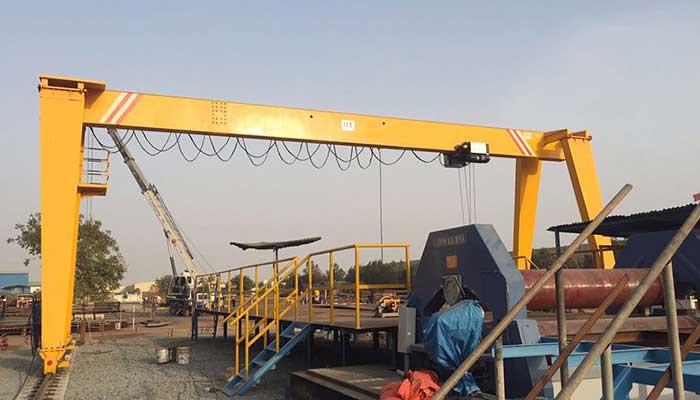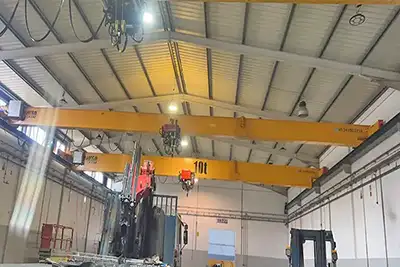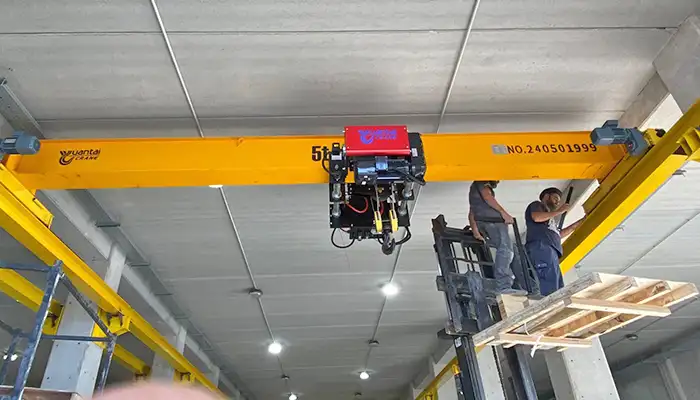Gantry Cranes in Bridge Construction Mold Handling 2 T to 50 Ton
Gantry Cranes in Bridge Construction Mold Handling
The towering structures that define our urban landscapes often conceal the intricate ballet of engineering and technology that takes place during their construction. In the realm of bridge construction, the critical role played by crane technology becomes apparent, shaping not only the skyline but also the efficiency and precision of the entire process. Among the diverse family of cranes, gantry cranes stand out for their specific prowess in handling molds for bridge components, orchestrating the dance of steel and concrete that gives rise to these colossal structures.
Bridge construction is a harmonious symphony of engineering precision and logistical intricacy. Each section, each beam, and every supporting structure must be meticulously crafted to ensure the safety and longevity of the finished bridge. In this symphony, cranes take center stage, lifting, positioning, and shaping the elements that will compose the bridge's anatomy.
Enter gantry cranes, the stalwarts of mold handling in bridge construction. Gantry cranes distinguish themselves with their elevated structures and versatile designs, making them ideal for the demands of lifting and positioning substantial molds, formwork, and structural components. The marriage of strength and precision in gantry cranes aligns seamlessly with the requirements of constructing bridges, where every piece must fit flawlessly into the intricate puzzle of the final structure.
Gantry cranes act as the bridge between the ground and the heights where bridges take shape. They play a pivotal role in navigating the challenges posed by large bridge molds, formwork, and the diverse range of structural components that constitute the anatomy of a bridge. As we delve into the specifics of gantry crane applications in bridge construction mold handling, we unravel the layers of technology and engineering that contribute to the creation of these engineering marvels. Join us on this exploration of how gantry cranes are not just lifting machines but orchestrators of progress, guiding the ascent of bridges into the skies.
Gantry Cranes: Engineering Marvels in Bridge Construction
Gantry cranes, often referred to as portal cranes, are imposing structures with horizontal beams supported by vertical legs. Their distinguishing feature lies in the ability to traverse horizontally along rails or tracks, covering a significant span. These cranes come in various configurations, with single girder and double girder designs, offering adaptability to different project requirements.
Key Characteristics:
- Elevated Structure: The horizontal beam of a gantry crane is elevated above the ground, providing the necessary height for lifting and maneuvering large bridge components.
- Traversable: Gantry cranes can move horizontally along rails or tracks, offering extensive coverage within the construction site.
- Versatility: Single and double girder configurations provide versatility, allowing for the handling of various loads with different spans.
Why Gantry Cranes for Mold Handling in Bridge Construction?
Gantry cranes are the stalwarts of mold handling in bridge construction due to several key attributes that align with the specific demands of the task:
Height and Span Capability:
- Elevated Reach: The elevated structure of gantry cranes allows them to reach the towering heights required for lifting and placing bridge molds.
- Extended Span: Gantry cranes can cover a wide span, providing ample coverage for the expansive construction sites where bridges take shape.
Load Capacity:
Heavy Load Handling: Bridge molds, formwork, and structural components are often massive. Gantry cranes, with their robust designs, boast high load capacities, making them capable of lifting and transporting these hefty elements with ease.
Precision and Control:
- Accurate Positioning: The horizontal and vertical movement capabilities of gantry cranes ensure precise positioning of molds, crucial for maintaining accuracy in the casting process.
- Customization: Gantry cranes can be customized with specific attachments and configurations tailored to the dimensions and weight of different bridge components.
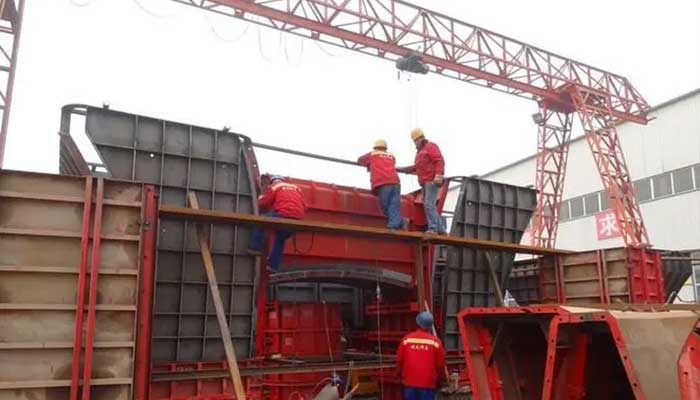
Single girder truss gantry crane for bridge contruction mold handling
Practical Considerations for Selecting Gantry Cranes in Bridge Construction Projects
Selecting the right gantry crane for bridge construction involves careful consideration of various factors:
Project Requirements:
- Bridge Size and Type: The dimensions and type of the bridge being constructed influence the required span and load capacity of the gantry crane.
- Construction Site Layout: The layout of the construction site, including any spatial constraints, determines the type and configuration of gantry crane that will be most efficient.
Load Characteristics:
Weight and Dimensions: Understanding the weight and dimensions of the heaviest loads to be handled is crucial for determining the appropriate gantry crane specifications.
Customization Options:
- Attachment Configurations: Gantry cranes can be equipped with various attachments, such as hooks, spreader beams, or specialized lifting devices, customized to the specific needs of bridge component handling.
- Adjustable Heights: The ability to adjust the height of the gantry crane ensures that molds can be positioned at different levels, accommodating the requirements of diverse bridge components.
Safety and Compliance:
- Safety Features: Ensure that selected gantry cranes are equipped with advanced safety features, such as overload protection and emergency braking systems, to guarantee a secure working environment.
- Compliance with Standards: Verify that the gantry crane adheres to industry standards and regulations, ensuring compliance with safety and performance requirements.
As we delve deeper into the realm of gantry cranes, their definition, characteristics, and suitability for mold handling become increasingly evident. The intricate dance of precision, strength, and adaptability showcased by gantry cranes makes them indispensable partners in the grand production of bridges that connect communities and stand as symbols of human engineering prowess.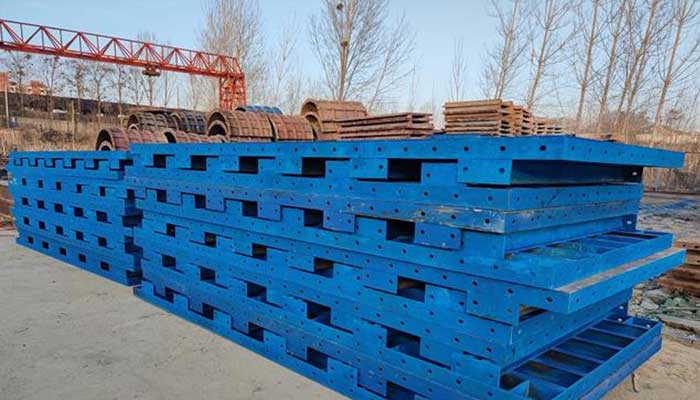
Typical Loads Handled
Large Bridge Molds
Description of Size and Weight
Large bridge molds stand as formidable components in the construction process, requiring specialized handling to ensure precision and safety. These molds, designed to shape the foundational elements of bridges, vary widely in size and weight. Typically, they encompass vast dimensions, ranging from tens to hundreds of feet in length, with corresponding widths and heights that mirror the scale of the intended bridge sections. The sheer mass of these molds can be substantial, often reaching several tons, emphasizing the need for robust lifting solutions.
Formwork
Importance in Creating Precise and Durable Bridge Components
Formwork plays a pivotal role in the creation of precise and durable bridge components. It serves as the mold into which concrete is poured, shaping the intricate details of the bridge's structure. Formwork must withstand the pressure exerted by the flowing concrete and ensure that the final components meet exacting specifications. The accuracy of the formwork directly influences the quality and integrity of the bridge elements produced. Gantry cranes, with their precise positioning capabilities, become essential in handling formwork, guaranteeing that each mold is carefully placed for optimal casting.
Structural Components
Bridge construction involves an array of structural components, each with its unique shape, function, and material requirements. These components span from the foundational elements such as abutments and piers to the superstructure elements like beams, girders, and deck segments. The diversity in these structural elements demands a versatile lifting solution capable of handling various shapes, sizes, and materials. Gantry cranes, with their ability to cover extensive spans and lift substantial loads, prove indispensable in managing the diverse range of structural components that collectively form a bridge.
Considerations for Gantry Crane Load Capacities
The selection of gantry crane load capacities becomes a critical consideration when handling different types of bridge components:
- Large Bridge Molds: High Capacity Requirement: Given the substantial size and weight of large bridge molds, gantry cranes need to have a high load capacity to safely and efficiently lift and position these molds.
- Formwork: Precision and Control: Gantry cranes, equipped with precise control mechanisms, are essential for the careful handling of formwork to ensure accurate placement and avoid any damage to the intricate details.
- Structural Components: Versatility: Gantry cranes with versatile configurations can adapt to the varying load capacities of different structural components, from the heavier foundation elements to the lighter superstructure elements.
- Customization: Customizing gantry crane attachments to match the specific requirements of each structural component enhances efficiency and ensures safe handling.
Typical Crane Applications
Handling and Positioning Molds for Casting Bridge Sections
Gantry cranes play a pivotal role in the meticulous process of handling and positioning molds for casting bridge sections. Their functionality extends beyond mere lifting, encompassing a nuanced dance of precision and control. Here's a detailed explanation of how gantry cranes facilitate this crucial aspect of bridge construction:
- Lifting Expertise: Gantry cranes, equipped with powerful hoisting mechanisms, effortlessly lift large bridge molds with precision and stability.
- Traversing Horizontally: The ability to traverse horizontally along rails allows gantry cranes to position themselves strategically for optimal mold handling, covering the entire span of the construction site.
- Adjustable Heights: Gantry cranes can be adjusted to different heights, accommodating the varying levels at which molds need to be positioned for casting.
- Custom Attachments: The flexibility to customize crane attachments ensures that each mold is lifted and positioned with the specific configuration required, ensuring a snug fit and accurate casting.
Importance of Accurate Mold Handling
Accurate mold handling is paramount for ensuring the quality and structural integrity of bridge sections. Gantry cranes, with their precise control and adaptable features, contribute to:
- Minimized Defects: Accurate positioning of molds minimizes the risk of defects in the finished bridge components, ensuring a smooth and flawless surface.
- Consistent Dimensions: The ability to precisely place molds guarantees consistent dimensions across all sections, contributing to the overall stability and safety of the bridge.
Construction Site Applications
Gantry cranes exhibit versatility in their utilization across various construction site scenarios, contributing to efficient mold handling throughout different stages of bridge construction:
- Foundation Work: Gantry cranes are employed in the installation of foundation elements, lifting and positioning molds for footings and abutments.
- Pier Construction: As the bridge structure ascends, gantry cranes play a vital role in handling molds for pier construction, ensuring the stability of vertical elements.
- Superstructure Erection: During the assembly of the bridge superstructure, gantry cranes delicately lift and place molds for beams, girders, and deck segments.
- Bridge Deck Placement: The final stage sees gantry cranes in action for the precise placement of molds forming the bridge deck, culminating in the completion of the structure.
Examples of Gantry Crane Roles
- Bridge Girder Placement: Gantry cranes are pivotal in the precise placement of large bridge girders, ensuring alignment and structural cohesion.
- Segmental Bridge Construction: In segmental bridge construction, gantry cranes are instrumental in handling molds for individual segments, facilitating the stepbystep assembly of the bridge.
Understanding the intricate applications of gantry cranes in handling molds—from the foundational stages to the culmination of bridge construction—reveals their indispensable role in orchestrating the ascent of bridges into the built environment. The adaptability and precision exhibited by gantry cranes elevate them beyond mere lifting apparatus, positioning them as key architects in the construction of monumental structures that span the realms of engineering excellence.
Benefits of Gantry Cranes in Bridge Construction
Gantry cranes emerge as indispensable assets in the realm of bridge construction, offering a multitude of benefits that extend beyond mere lifting capabilities. Their impact reverberates through increased efficiency, precision, safety, and costeffectiveness.
Increased Efficiency
Streamlining the Mold Handling Process
Gantry cranes act as efficient choreographers, streamlining the mold handling process to enhance overall productivity. Their contributions include:
- Rapid Positioning: The ability to swiftly move and position along the construction site ensures that molds are placed with precision, minimizing delays in the casting process.
- MultiDirectional Movement: Gantry cranes' capability for multidirectional movement allows for seamless transitions between various work areas, optimizing the workflow.
Reducing Downtime
Efficient gantry crane operations result in reduced downtime, a critical factor in the timesensitive domain of bridge construction:
- Quick Changeovers: Gantry cranes facilitate rapid mold changeovers, ensuring that the construction process can seamlessly progress from one phase to the next.
- Continuous Workflow: The minimized downtime allows for a continuous workflow, preventing unnecessary delays and contributing to the timely completion of the bridge project.
Precision and Safety
Ensuring Accurate Positioning
The precise control offered by gantry cranes is instrumental in ensuring accurate positioning of molds, fostering the creation of highquality bridge components:
- Consistent Dimensions: Accurate mold handling guarantees the consistency of dimensions across all bridge sections, contributing to the structural integrity of the entire bridge.
- Minimized Defects: The precision in positioning reduces the risk of defects in the finished components, enhancing the overall quality of the bridge structure.
Importance of Safety Features
Safety is paramount in bridge construction, and gantry cranes are equipped with features to safeguard both workers and equipment:
- Overload Protection: Gantry cranes are designed with overload protection mechanisms, preventing the crane from lifting loads beyond its capacity and ensuring safe operations.
- Emergency Braking Systems: Advanced braking systems contribute to swift and controlled stops in emergency situations, enhancing overall job site safety.
CostEffective Solutions
Evaluation of CostEffectiveness
Gantry cranes present a costeffective solution in bridge construction, considering both immediate and longterm factors:
- Initial Cost vs. Operational Efficiency: While the initial investment in gantry cranes may vary, their operational efficiency and timesaving features contribute to cost savings over the course of the project.
- Reduced Labor Costs: The efficiency of gantry cranes often leads to reduced reliance on manual labor for mold handling, resulting in additional cost savings.
Consideration of LongTerm Operational Costs and Maintenance
- Predictive Maintenance: Gantry cranes can be equipped with predictive maintenance features, allowing for timely inspections and repairs to prevent unexpected breakdowns and associated costs.
- Durability and Longevity: Robust designs and quality construction contribute to the longevity of gantry cranes, minimizing the frequency of replacements and associated capital expenditures.
Gantry Crane Buying Guide for Crane Buyers and Users
Investing in a gantry crane is a strategic decision that requires careful consideration to ensure it aligns with the unique demands of a bridge construction project. This comprehensive buying guide provides crane buyers and users with key considerations, customization options, compliance and safety standards, and insights into maintenance and service contracts.
Key Considerations
Understanding Specific Project Requirements
- Bridge Construction Project Details: Assess the scope, size, and intricacies of the bridge construction project to determine the ideal gantry crane specifications.
- Weight and Dimensions: Accurately assess the weight and dimensions of the heaviest loads to be handled, considering both current and potential future requirements.
Customization Options
Tailoring Gantry Crane Specifications
- Hoist Type: Explore different hoist types, such as wire rope hoists or electric chain hoists, and choose the one best suited for the nature of the loads and the project's demands.
- Span Length: Determine the required span length based on the layout of the construction site, ensuring the gantry crane can cover the entire working area efficiently.
- Lifting Height: Customize the lifting height to match the specific requirements of the construction site, accommodating variations in elevation and placement needs.
Compliance and Safety Standards
Ensuring Adherence to Industry Standards
- Industry Regulations: Gain a thorough understanding of industry standards and regulations related to gantry crane design, manufacturing, and operation.
- Safety Certifications: Prioritize gantry cranes with safety certifications, ensuring that they meet or exceed established safety standards. Look for features such as overload protection and emergency braking systems.
Maintenance and Service Contracts
Sustaining LongTerm Efficiency
- Regular Maintenance Schedules: Establish regular maintenance schedules for gantry cranes to prevent unexpected breakdowns and prolong their operational lifespan.
- Predictive Maintenance: Consider gantry cranes equipped with predictive maintenance features, allowing for timely inspections and repairs based on realtime data.
- Service Contracts: Explore the value of service contracts with crane manufacturers or service providers for ongoing support, quick issue resolution, and access to expert maintenance personnel.
Investing in a gantry crane for bridge construction involves a multifaceted decisionmaking process. By understanding project requirements, customizing crane specifications, adhering to safety standards, and implementing robust maintenance practices, crane buyers and users can ensure that their investment not only meets immediate needs but also stands the test of time, contributing to the success of the bridge construction endeavor. The careful selection and utilization of gantry cranes serve as a testament to a commitment to efficiency, safety, and the seamless orchestration of construction operations.
Improved Efficiency, Safety, and Precision
- Efficiency in Segmental Construction: Gantry cranes facilitated efficient segmental construction of a bridge, showcasing how their precise positioning capabilities minimized construction time and reduced the need for extensive manual labor.
- Safety in Urban Environments: In an urban bridge construction scenario, gantry cranes demonstrated their safety features, ensuring stable lifts and controlled movements even in confined spaces. The incorporation of safety certifications and emergency braking systems contributed to a secure working environment.
- Precision in Arch Bridge Construction: Gantry cranes showcased their precision in the construction of an arch bridge, where accuracy in mold handling was paramount. The ability to customize hoist types and lifting heights ensured the creation of a structurally sound and aesthetically pleasing bridge.
The case studies and realworld scenarios presented here underscore the transformative impact of gantry cranes in bridge construction. Beyond being mere lifting apparatus, gantry cranes emerge as indispensable partners in achieving project success. The showcased projects highlight the adaptability, efficiency, safety, and precision that gantry cranes bring to the complex task of mold handling in bridge construction. As bridges continue to shape our landscapes, gantry cranes stand as silent orchestrators, guiding the ascent of these architectural marvels with grace and precision.
Case Studies and Practical Examples
In the realm of bridge construction, the practical application of gantry cranes unfolds through compelling case studies and realworld scenarios. These examples showcase how gantry cranes contribute to the success of bridge projects, emphasizing improved efficiency, safety, and precision in mold handling.
Showcase of Successful Bridge Construction Projects
Gantry Cranes at Work
- Golden Gate Bridge, San Francisco: Gantry cranes played a pivotal role in the construction of the iconic Golden Gate Bridge. Their ability to handle large bridge molds and precisely position components contributed to the efficient assembly of this engineering marvel.
- Akashi Kaikyō Bridge, Japan: The Akashi Kaikyō Bridge, one of the longest suspension bridges globally, relied on gantry cranes for the precision handling of intricate components. This case study highlights the adaptability of gantry cranes in managing diverse structural elements.
- Millau Viaduct, France: Gantry cranes were integral to the construction of the Millau Viaduct, the tallest bridge in the world. Their efficiency in lifting and placing molds for the towering piers and expansive deck segments showcased the versatility of gantry cranes in complex bridge projects.
Improved Efficiency, Safety, and Precision
- Efficiency in Segmental Construction: Gantry cranes facilitated efficient segmental construction of a bridge, showcasing how their precise positioning capabilities minimized construction time and reduced the need for extensive manual labor.
- Safety in Urban Environments: In an urban bridge construction scenario, gantry cranes demonstrated their safety features, ensuring stable lifts and controlled movements even in confined spaces. The incorporation of safety certifications and emergency braking systems contributed to a secure working environment.
- Precision in Arch Bridge Construction: Gantry cranes showcased their precision in the construction of an arch bridge, where accuracy in mold handling was paramount. The ability to customize hoist types and lifting heights ensured the creation of a structurally sound and aesthetically pleasing bridge.
The case studies and realworld scenarios presented here underscore the transformative impact of gantry cranes in bridge construction. Beyond being mere lifting apparatus, gantry cranes emerge as indispensable partners in achieving project success. The showcased projects highlight the adaptability, efficiency, safety, and precision that gantry cranes bring to the complex task of mold handling in bridge construction. As bridges continue to shape our landscapes, gantry cranes stand as silent orchestrators, guiding the ascent of these architectural marvels with grace and precision.


